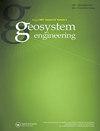Roasting of pyrophyllite for application in aluminoborosilicate glass production
IF 1.1
Q3 GEOSCIENCES, MULTIDISCIPLINARY
引用次数: 3
Abstract
ABSTRACT Pyrophyllite, an aluminum silicate mineral, was used as a raw material for the production of aluminoborosilicate glass. For the application of pyrophyllite to the glass manufacturing process as a raw material, the particle size distribution of the powder must the following requirements: 150–45 μm ≥ 60 mass% and below 45 μm ≤ 40 mass%. Hence, an attempt was made to develop the technology for pyrophyllite to produce a powder that meets these requirements through understanding the crushing characteristics. Roasting of pyrophyllite at 1150 °C resulted in the alternation of raw pyrophyllite and led to differences in the crushing characteristics. Crushing of the roasted pyrophyllite produced a powder with a reduction in the amount of the fine particles (−45 μm) compared to the powder of the raw pyrophyllite under identical crushing condition. This difference is attributed to the alternation of the raw pyrophyllite after the roasting process, as confirmed by powder X-ray diffraction (XRD) and scanning electron microscopy (SEM) results as well as by the amount of water adsorption. The melting characteristics of the raw and roasted pyrophyllite samples were investigated for application to the aluminumborosilicate glass production. The glass products are characterized as colorless and in an amorphous phase.叶蜡石焙烧在铝硼硅酸盐玻璃生产中的应用
叶蜡石是一种铝硅酸盐矿物,被用作生产铝硼硅酸盐玻璃的原料。叶蜡石作为原料应用于玻璃制造过程中,粉末的粒度分布必须满足以下要求:150–45μm≥60质量%,45μm以下≤40质量%。因此,试图开发叶蜡石技术,通过了解其破碎特性来生产满足这些要求的粉末。叶蜡石在1150°C下的焙烧导致了原叶蜡石的交替,并导致了破碎特性的差异。在相同的破碎条件下,与生叶蜡石粉末相比,对焙烧叶蜡石进行破碎可产生细颗粒(−45μm)减少的粉末。如粉末X射线衍射(XRD)和扫描电子显微镜(SEM)结果以及水吸附量所证实的,这种差异归因于焙烧过程后原始叶蜡石的变化。为应用于硅酸铝玻璃生产,研究了生叶蜡石和焙烧叶蜡石样品的熔融特性。玻璃产品的特征是无色且呈无定形相。
本文章由计算机程序翻译,如有差异,请以英文原文为准。
求助全文
约1分钟内获得全文
求助全文

 求助内容:
求助内容: 应助结果提醒方式:
应助结果提醒方式:


